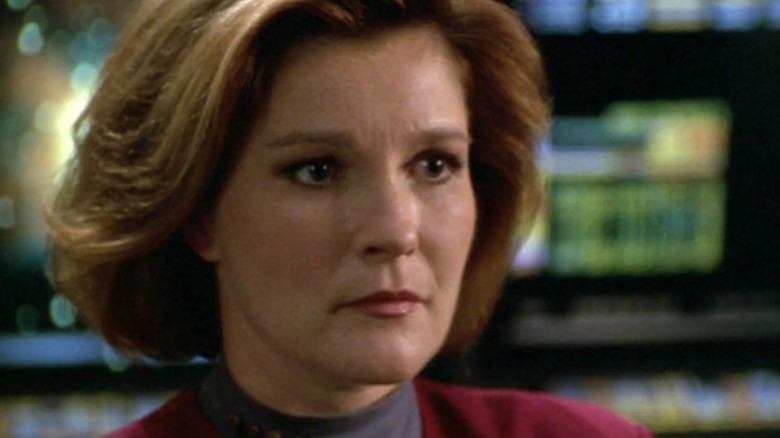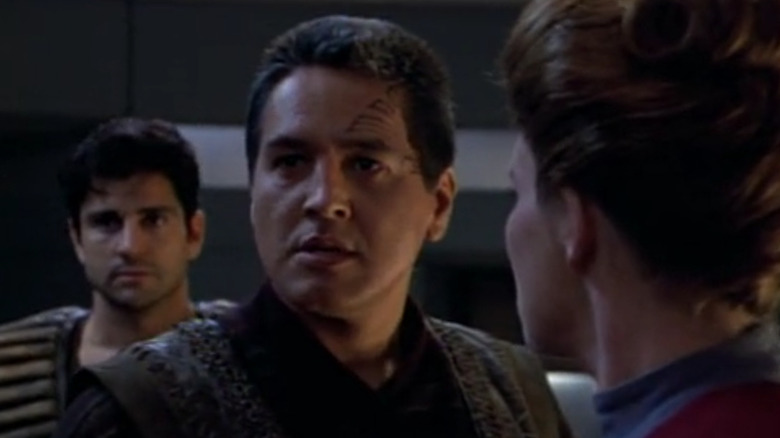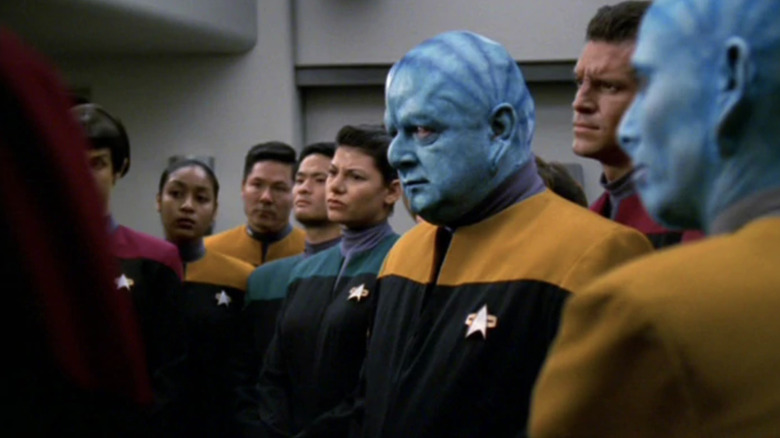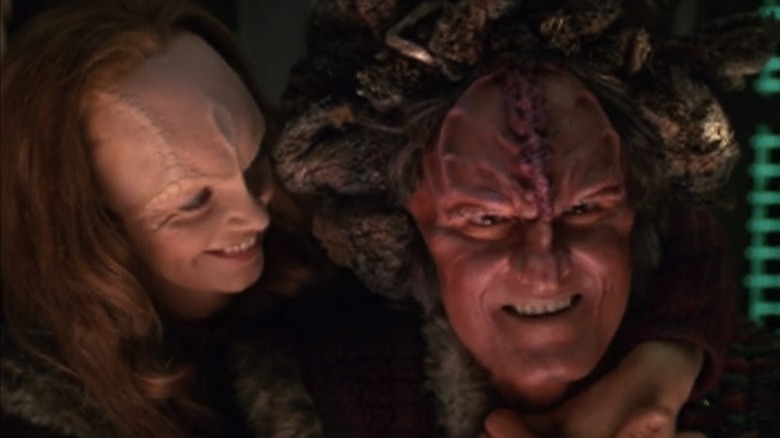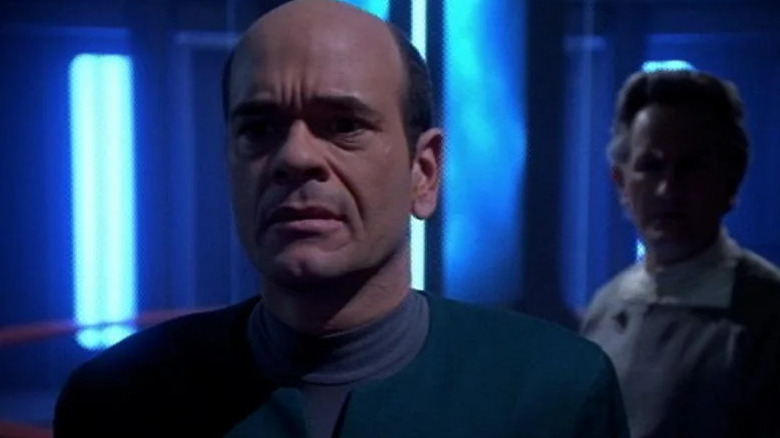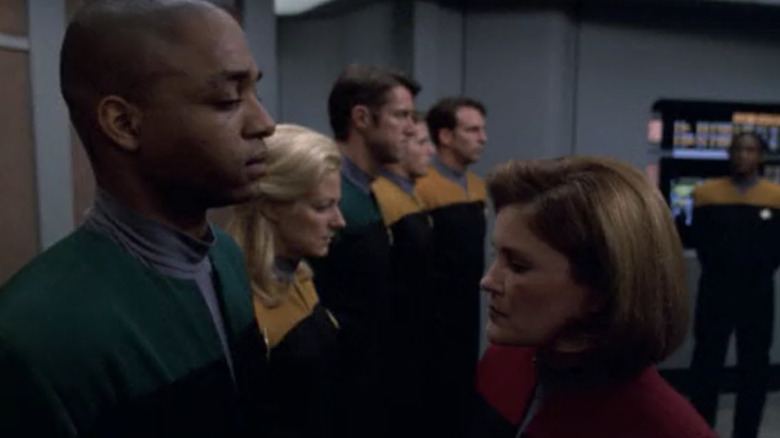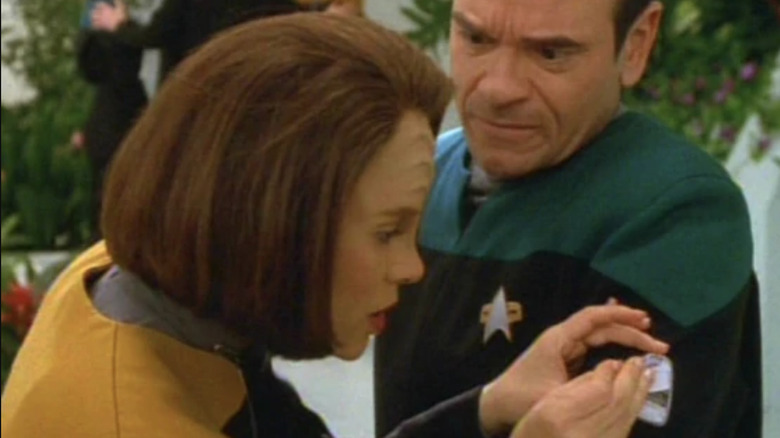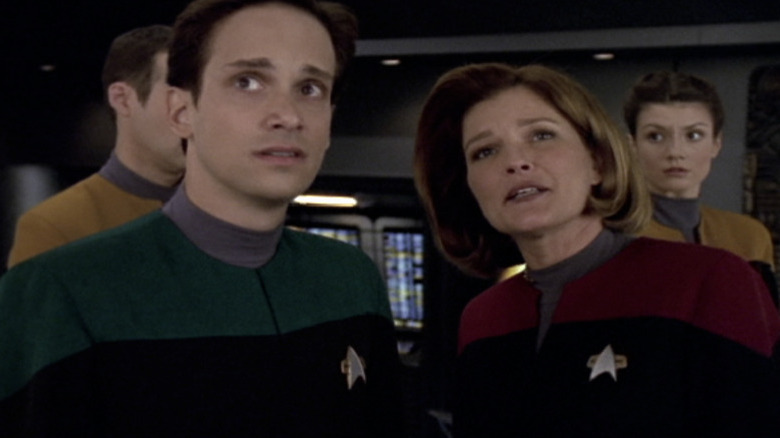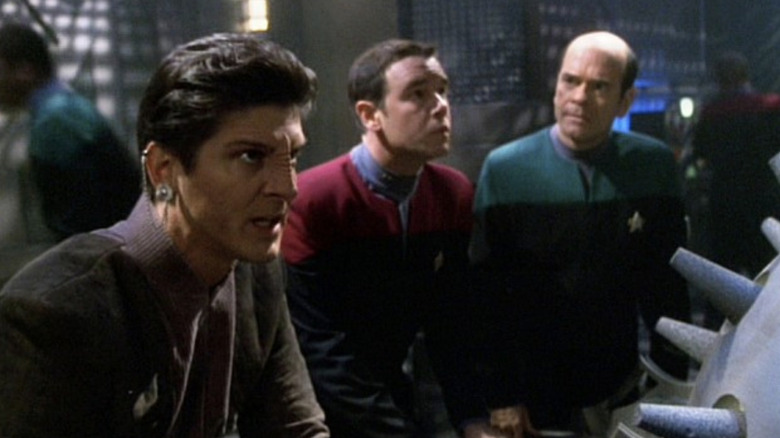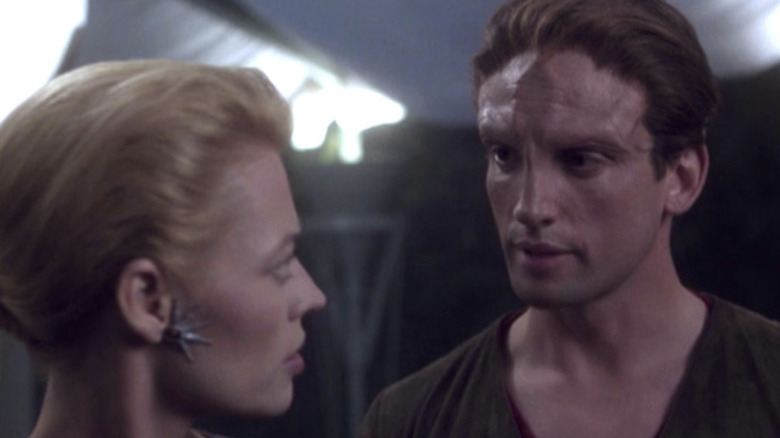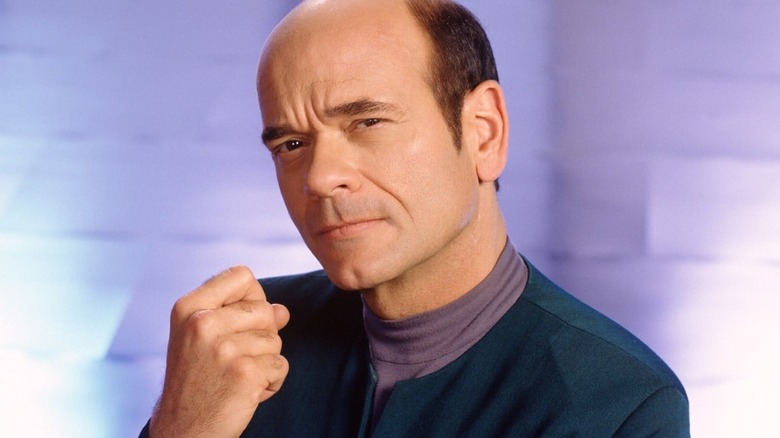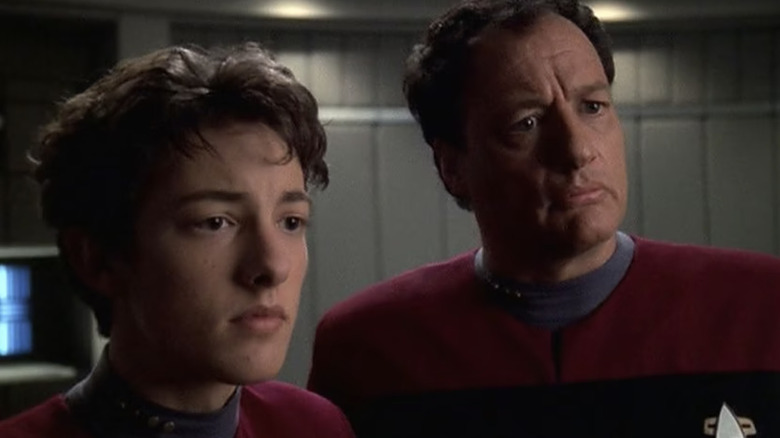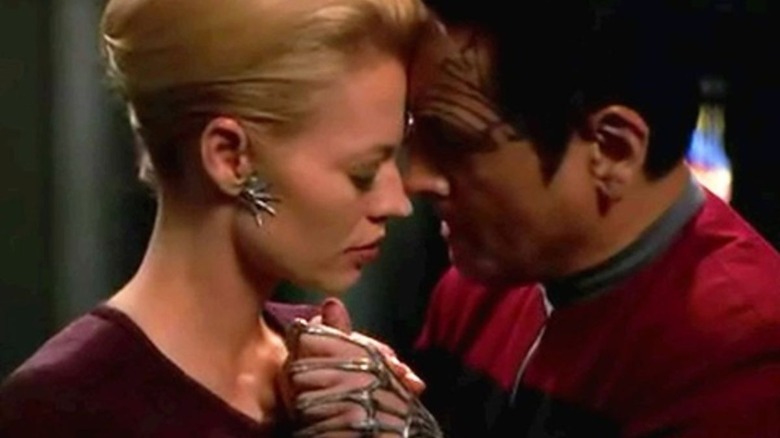Unresolved Plotlines From Star Trek: Voyager
"Star Trek: Voyager" debuted in January 1995 in a midseason ratings bonanza that took the sci-fi franchise boldly where it had never gone before: into the distant Delta Quadrant. Separated from Starfleet and the Federation, the crew of the USS Voyager — forced to merge with the crew of a rogue Maquis starship — set out to make their way back to Earth in a journey they expect to take 75 years.
Along the way, they come into contact with a variety of new allies and villains, from the Kazon and the Hirogen to the Ocampa and the Talaxians. They face off against the Borg in their own territory and make first contact with a trans-dimensional race known only as Species 8472. From story to story, they travel their path Earth-bound, but some of these tales get lost on their way home. In a series where the ship can't stop anywhere for very long, it's unavoidable that some plot points go unresolved, with friends and enemies inevitably put in the rearview mirror.
With shows like "Star Trek: Picard" and "Star Trek: Discovery" both taking place past the events of "Voyager," though, it's possible we may get some of these loose ends tied up in the coming years. But for now, here's a list of unresolved plotlines from "Star Trek: Voyager."
Conflict among a mixed crew
During the "Next Generation" era, creator Gene Roddenberry's intended there to be no conflict among Starfleet crew, and writers often had to find other ways to create tension. As "TNG" was ending, they came up with a perfect solution: the Maquis, a group of freedom fighters who opposed peace with Cardassians and split with the Federation. "Star Trek: Voyager" was built off the premise that a group of Maquis is forced to partner with the crew of a Starfleet ship, creating a perfect breeding ground for conflict that wouldn't violate Roddenberry's tenet.
The problem was, by the end of the show's premiere, all of the Starfleet-hating Maquis (who should have been imprisoned for their crimes) weren't just free to walk about the ship — they were also wearing Starfleet uniforms. Indeed, their embittered, angry leader tucked his tail between his legs and became a by-the-book first officer. After a handful of stories that exploited the inherent personality clashes, everyone seems to get along pretty well, even with helmsman Tom Paris. Notably, in the premiere, Paris is shown to have had a personal beef with Chakotay that's never really revealed despite the pair almost coming to blows during their first meeting. The show's producers had made a big deal of sticking the two crews together when the series launched, but it's largely glossed over and left completely unresolved after the show's 1st season.
The fate of the Maquis crew members
Besides their unresolved conflict with their Starfleet shipmates, the bigger question is what became of the Maquis after Voyager returned to the Alpha Quadrant in the series finale, "Endgame." While Captain Janeway may have been forced to allow the Maquis to join the ship as bonafide members of the crew due to their unique circumstances (something even security chief Tuvok disagrees with), it remains to be seen if Starfleet on Earth is as forgiving. We'd seen on "Deep Space Nine" that just being a member of the rogue organization was grounds enough to warrant prison time, and even on "Voyager," we saw Tom Paris in a Federation penal colony for treason after joining the group of intrepid freedom fighters. We can't imagine, despite their "time served" in the Delta Quadrant — or their upstanding behavior while aboard Voyager — that there would be no repercussions at all.
In fact, in the episode "Life Line," when Voyager is able to have regular communication with Starfleet back on Earth, Admiral Hayes even asks about "the status of the Maquis," suggesting they are preparing for their imminent arrival in the Alpha Quadrant and are considering what to do with them. When they did return in the finale, we never got an answer to that dilemma, as the credits rolled shortly after their arrival, leaving several plot threads dangling.
The Kazon war and baby Seska
For more than two seasons, the primary antagonists of "Star Trek: Voyager" were from the violent race known as the Kazon — a more primitive alien people than the Federation was used to battling. They lacked much of the advanced technology that Starfleet boasts and were made up of decentralized factions that had been fighting amongst themselves for centuries. But without Federation starbases or allies in the Delta Quadrant, the Voyager crew found themselves overwhelmed, despite being far more advanced and organized. At the same time, the various Kazon sects suddenly had a new and dangerous common enemy to unite them. Throw in the Cardassian undercover agent Seska, who betrays Voyager and joins the Kazon, and you've got a recipe for some great stories.
In one of the rare serialized stories on the show, Seska — now an ally of the Kazon — eventually works with a disgruntled Maquis aboard Voyager who leaks sensitive information to the enemy. In the end, Seksa ends up betrothed to the Kazon leader Culluh, with whom she has a half-Kazon, half-Cardassian child. Though Seska's story would come to an end in the episode "Basics, Part II," her child's destiny remains unknown. Ultimately, the Kazon were left in the rear view mirror as Voyager ventured out of their territory on their journey to Earth, leaving the conclusion of the Kazon civil war and the fate of Seska's half-Kazon child a mystery.
The variant Doctor's destiny
"Living Witness" is one of the most unique episodes of "Voyager," set 700 years in the show's future where two planets still fight over who started their centuries-old war. Issues of discrimination remain from their long struggle, but it's Voyager's part in their history that proves controversial when a backup of the Doctor's program is discovered in some ancient ruins. Activated centuries after Voyager passed through their system, the Doctor is essentially put on trial for Voyager's involvement in the bloody war. Attempting to clear Voyager's good name, the Doctor tells his side of the story, insisting that they were mere passersby and not the instigators the two sides claim.
In the end, the matter is never truly settled, but the two sides seemingly agree that this duplicate Doctor is not the one the blame. In a closing scene, we learn that after telling his story, the Doctor serves as a Surgical Chancellor on the distant future world before setting off in a small vessel to reach Earth and find out what happened to Voyager 700 years later. "What became of him?" they ask, and we never get an answer. With "Star Trek: Discovery" now taking place in the 32nd century, though, it's been enough time for this variant of the Doctor to have reached Earth, so we may yet find out what happened to him.
What happened to the Equinox crew aboard Voyager?
In possibly one of the most intense and exciting "Star Trek: Voyager" two-parters, Janeway and company are shocked to encounter another Federation starship in the Delta Quadrant. It seems that the USS Equinox and its notorious and revered Captain Ransom have been catapulted there by the same entity that displaced Voyager. But what is at first a glorious and happy reunion becomes a fight for survival when it's discovered that Ransom and his crew have been conducting gruesome experiments on alien creatures and using their corpses to fuel their warp drive. In a dramatic story that would be echoed by "Battlestar Galactica" and its meeting with the Pegasus, the two ship's become adversaries, with Janeway attempting to bring Ransom to justice as the Equinox kidnaps and tortures Seven of Nine while reprogramming the Doctor to turn him into a sadistic surgeon.
At the end of the story, Ransom has a change of heart, but it's too late, as his first officer refuses to turn back. Ransom sacrifices himself to stop his mutinied crew, and Janeway is able to put an end to their despicable alien experiments. Several of the crew survive, though, and Janeway reluctantly welcomes them to Voyager, noting in the episode's conclusion that she'll be keeping a close eye on them. Unfortunately, the likes of Noah Lessing and Marla Gilmore are never seen again, squandering what could have been a compelling story of the Equinox crew seeking redemption.
The implications of the mobile emitter
In the two-part episode "Future's End," which sees an advanced Time Ship from the 29th century pursue Voyager into the past, the Doctor is fitted with a new piece of hardware created using technology far more advanced than the crew's own. This new mobile emitter frees him from the confines of sickbay for the remainder of the series, but something that is never really discussed about the little device (that was clearly designed as a way to help the show's writers come up with new stories for the Doctor) is the world-altering implications of such technology.
In fact, in the episode "Drone," the advanced mobile emitter does prove to be a threat when a Borg drone is born from its 29th-century technology and is nearly acquired by the collective. Yet not only does the crew continue to reap the benefits of a device — even though its use is a clear violation of the Temporal Prime Directive — they also take it back with them to the Alpha Quadrant where, presumably, Starfleet has the opportunity to reverse engineer it. But even within the confines of "Star Trek: Voyager," the broader implications of such far-flung future tech existing in the crew's time are given surprisingly little attention. Ultimately, the audience is never given any idea of what would or could become of it when the ship finally returns home to Earth.
Lower Decks crew members on Voyager
In at least two episodes of "Voyage," we are introduced to the "lesser" crew members aboard the ship; officers on the "Lower Decks," so to speak. In "Good Shepherd," some of them come to Janeway's attention. Specifically, they are officers who are not contributing enough to the ship, either because they are less than qualified or because they are not getting the help they need. It's a touching episode about reaching out to those who need a little special attention to help them face their personal struggles. At the end of the episode, all of them become appreciated for the unique gifts they bring to the ship, with Janeway helping them understand that everyone has an important role to play.
Likewise, in the 1st season episode "Learning Curve," security chief Tuvok finds a handful of ex-Maquis who are not fitting in and tries to help them assimilate into Voyager's rigid Starfleet structure. It's one of the few times we get a look at the struggle between Starfleet and Maquis, but it also illustrates how that conflict was left unresolved. Notably, by the end of the episode, the Maquis do a heel turn and agree to try harder, do better, and become model officers. But in the case of both episodes, despite spending considerable time with these misfit crew members, we never revisit them through the rest of the series and never find out if they became the better officers it was implied they would.
The hologram civilization
In another two-parter, Season 6's "The Killing Game," we find the hunter species known as the Hirogen have used Voyager's hologram technology — given to them in the prior episode "Prey" — to create an entire army of holographic people that are used as targets in their ritual hunts. The problem is that they've given their holographic enemies sentience, which horrifies the Doctor, who sees the new holograms as not just his brothers and sisters but also a new race to which he belongs. After Janeway attempts to shut down the holograms, who are led by a fanatical Bajoran isomorph named Iden, the Doctor defects and tries to help them in their quest for freedom.
The episode closes with the Doctor returning to Voyager and Iden being deposed, with a new holographic leader anointed to carry on their mission to find a new home. It's implied that they will establish their own civilization and find a way to live in peace with "organics," but what could have been a genuinely intriguing ongoing story is given zero follow-up. This is, unfortunately, the nature of "Voyager" — as the ship progressed on its journey to the Alpha Quadrant, it often was forced to leave its best stories behind.
The Borg rebellion
The Voyager crew always seemed to be getting themselves involved in uprisings, rebellions, and civil wars, and in the 6th season cliffhanger, "Unimatrix Zero," they did it again. This time, ex-Borg Seven of Nine discovers a collective unconscious dubbed "Unimatrix Zero," a state that Borg drones enter while inactive where they are able to reclaim their original personalities. Through this collective dream state, the drones are able to plan a form of mutiny over the Borg. The only problem is that once they are activated in the real world, the drones forget everything that happens in Unimatrix Zero. That's where Seven of Nine comes in, because thanks to her unique nature, she can remember what she experiences while sharing their dream state and helps them plan a Borg rebellion.
After a tense battle with the Borg that sees the queen discover their plot, Unimatrix Zero is destroyed, but not before those in it reclaim their identities in the waking world and promise to continue their fight to destroy the queen and her collective. Sadly, we never see the rest of their story, despite seeing the Borg once more in the series finale. But the Borg Queen is due to return in the second season of "Star Trek: Picard," so perhaps we will learn if the Borg rebels had some measure of success.
Is the Doctor a person?
From the very beginning of the series, the character of the holographic Doctor is the topic of much discussion. Is he a person, or just a program? He may begin life as a slightly robotic subroutine performing basic sickbay functions — even coming across early on as little more than a humanoid tool — but as the series progresses, he becomes much more. Imbued with a growing personality, it's Kes who first insists that the Doctor is a person and helps him argue for more rights and privileges aboard the ship. Eventually, the Doctor gets control of his "on" and "off" switch — a major step towards autonomy — and after receiving his mobile emitter, there is little that separates him from any other member of the crew.
The subject of his personhood, however, is not really decided. We're never given a declarative resolution in the same way that "Star Trek: The Next Generation" did for Commander Data in "The Measure of a Man." Despite several episodes — like the 5th season's "Latent Image" — focusing on his status as an autonomous person, the matter is left open. Even in one of the last episodes of the series, "Author, Author," that focuses almost entirely on the issue, it's only decided that he has the right to control his creative work, with his human rights and status as a person still left unresolved.
The evolution of the Q continuum
John de Lancie returned to "Star Trek" in the "Voyager" episode "Death Wish," and right away, we see there are problems in the Q Continuum. The race of omnipotent beings is undergoing an existential crisis of sorts, with at least one of them hoping to end his own life. He eventually gets his wish, and In "The Q and the Grey," the continuum sees the consequences when the Q are engaged in a bloody civil war, with the galaxy caught in the cosmic crossfire. Q believes that if can procreate with Janeway, he can transform the continuum by fusing the omnipotence of the Q with the best of humanity. Ultimately, Q mates with a fellow Q instead, with the hope that they can create a new messiah and bring about an evolution of his people.
While the introduction of Q2 in the follow-up suggests that maybe such an evolution is underway, the younger Q didn't seem any different or revolutionary, and it didn't feel like anything had really changed. It seems that the emergence of a Q child was merely a stop-gap measure, and the continuum could still be facing a battle for its very soul. Perhaps we'll find out more about the state of his people when John de Lancie's Q returns in the next season of "Star Trek: Picard."
Chakotay and Seven of Nine
Like "Star Trek: The Next Generation" inexplicably pairing up Lieutenant Worf and Counselor Troi in the show's final season, "Star Trek: Voyager" forced the romantic coupling of two of the show's biggest stars, Commander Chakotay and Seven of Nine. Chakotay was probably the only male cast member who hadn't hit on Jeri Ryan's ex-Borg when she first joined the show in the 4th season, so he must have been the obvious choice when they needed to find her a romantic partner. Like "TNG," it seems the only reason to match them up was to give some emotional weight to a character death in the alternate future of the show's series finale. But unlike the coupling of Worf and Troi, the courtship was rushed and haphazard, which is probably why it was abandoned without explanation when Seven of Nine returned in "Star Trek: Picard." You'd think a former Maquis soldier like Chakotay would have joined his lover in her fight with the Fenris Rangers, but it seems when we meet her again some 20 years later, Seven is alone and unpartnered.
Perhaps with rumors that the show's 2nd season will dig a bit deeper into her blossoming relationship with Raffi, we may get a mention of her split with Voyager's first officer. For now, though, it remains one of the show's biggest unresolved plotlines.
